UF/IFAS Extension hosted a successful food systems tour of Flagler County for many interested legislators on March 15, 2018. Dr. Wendy Mussoline, Agricultural Extension Agent for Putnam and Flagler Counties, organized the event and partnered with Flagler Farm Bureau, Flagler Cattlemen’s Association, and many local farmers to showcase their contribution to Flagler food systems. All of the Flagler County Commissioners were in attendance as well as other important decision makers including State Representative Paul Renner, District Representative for US Congressman Ron DeSantis, (Drew Meiner), and Joe Mayer (Community Services Director for Flagler County). The purpose of the tour was to help leaders take an in-depth look at agriculture and its vital contribution to the economy and nutritional vitality in Flagler County and to the world. The focus of the tour was to identify how our local growers are creating sustainable food systems and enabling environments that promote healthier dietary practices.
Seay Farms
Matt Seay has diversified his farming operation to maintain economic viability in changing markets that are demanding healthier foods. He has transitioned approximately 50% of his farmland (1000 acres) from chip potatoes into more nutritious crops including cauliflower, broccoli, beets, collards, mustards, turnips, kale and cilantro. He faced several challenges in the transition including erratic weather patterns, cultivar selection, and optimization of fertility schemes since each crop has different nutritional requirements. But Matt and his wife (who recently transitioned into a full- time position at the farm) are committed to making a positive economic impact on the Flagler County food system.
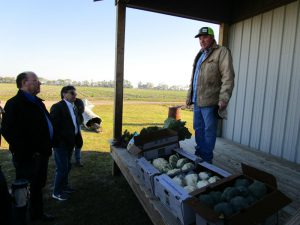
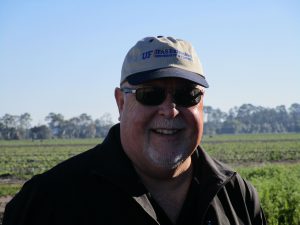
Hollar & Greene
The fourth generation, family-owned Greene’s Farm showcased their cabbage and helped to educate participants on their transition to organic cabbage production. There are currently 937 planted acres of cabbage and the varieties include Rio grande red cabbage, a Savoy cabbage ‘Clarissa’, and three traditional green cabbages – Bravo, Bronco and Capture. This year they have expanded their organic farming operation to 134 acres to meet the demands of their market. Their red cabbage offers an additional nutritional benefit due to the presence of anthocyanins, which are laden with antioxidants and possess anti-inflammatory and anti-carcinogenic activity, cardiovascular disease reduction, and obesity control.
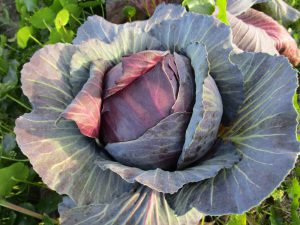
WP Rawl & Sons
We all put on our hair nets (and beard nets if necessary) and walked through the foot wash station to meet the food safety requirements while visiting the 34,000-square foot, temperature-controlled packing house at WP Rawl & Sons. The smell of cilantro permeated the building as that was the harvested crop for the morning. Their primary crops including collard greens, kale, turnip greens, mustard greens, herbs and beets. This year they dedicated 183 acres to organic production to support the increasing demand of their customers. Their largest organic buyers are Costco and Whole Foods, while their largest conventional customers are Publix and Walmart. Their goal is to provide immediate chilling of the produce as it comes out of the field to maximize the preservation of the nutrients contained in those leafy green vegetables.
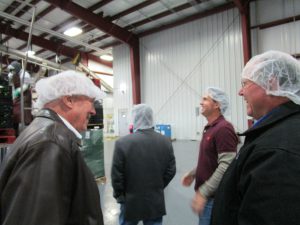
Clegg Sod and Hay Farm
David and Wanda Clegg shared the story of how they transitioned from a 100% sod farm into a more diversified sod and forage operation. Since 2009, the Cleggs have converted 165 acres of St. Augustine grass used for residential development into bermudagrass used for hay production. Thanks to the initial help of UF/IFAS faculty, they now produce high quality livestock feed from both Tifton 85 and Jiggs bermudagrasses. An additional 40 acres were converted into Lympograss for both grazing and hay production. They now supply three local feed stores (namely Pierson Feed, A&S Hardware, and Crescent City Feed) with an annual supply of high quality hay for customers. Neighboring farmers often take notice of the fresh cut hay and are welcome to buy it directly from the farm office.

Brian Anderson Ranch
Brian Anderson graciously provided our final stop and luncheon location, staged with 70 heifers and their calves lined up at the edge of the pasture feasting on nutritious, ensiled Jiggs bermudagrass. Brian’s daughter, Alexis, is an active member of FFA and she shared that the key to a healthy breeding program is providing proper nutrition to pregnant cows so they can provide the appropriate nutrients to their calves. Brian grows his own forage and converts it into haylage by baling and wrapping it in plastic. This promotes fermentation of the material and stores the nutrient quality for longer periods of time. Thus, he can feed his cattle through the winter months when forages are scarce. Brian’s average breeding rate with his predominantly Brangus herd is around 90%, and he attributes this success to high-quality, nutritious feed. Brian has served a term as the State Director for the Flagler County Cattlemen’s Association and has been instrumental in promoting Best Management Practices (BMPs) within the beef cattle industry in Flagler County. The luncheon was held on Brian Ranch and sponsored by Flagler Farm Bureau and Flagler Cattlemen’s Association. All the growers that we visited graciously provided freshly harvested vegetables in advance and the lunch was prepared and catered by Penny Buckles with Country Wedding and Event Planning, Inc.
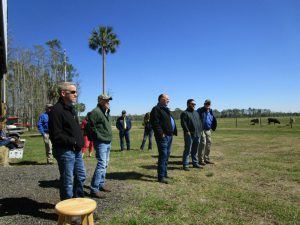

Final Words
Amy Hedstrom (UF/IFAS 4-H Agent) spoke to the group about the many agricultural opportunities that our youth have through diverse 4-H programs. Gary England, Regional Specialized Extension Agent at the Hastings Agricultural Extension Center, wrapped up the tour by discussing the various, on-going, relevant farm trials at the Hasting farm. He discussed the different trials that involve cultivar selection, varying fertility schemes, and advanced crop production methods for several different alternative crops including broccoli, cauliflower, sweet potatoes, brussels sprouts, and even artichokes (just to name a few from this season). He emphasized the beneficial and necessary partnerships with Tri-County legislators to help support the on-going research at the Hastings farm.
 0
0
